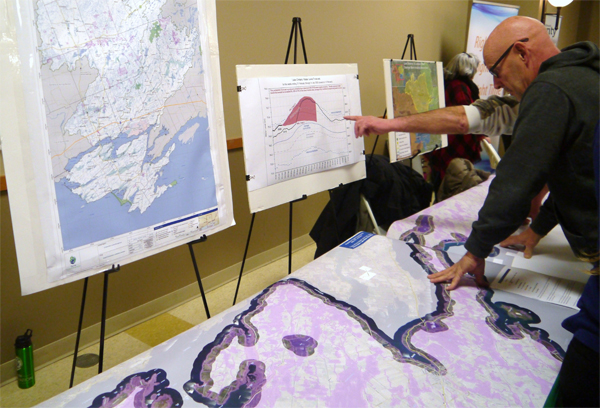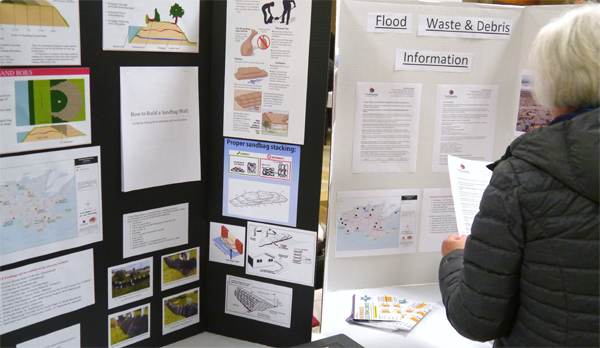2020 flood preparation meeting draws 450 residents
Administrator | Feb 20, 2020 | Comments 0
 Story and photos by Sharon Harrison
Story and photos by Sharon Harrison
Prince Edward County Mayor Steve Ferguson brought news of a good discussion with Deputy Prime Minister Chrystia Freeland, to some 450 people who went to the municipality’s flood preparation open house and meeting Wednesday night at the Wellington and District Community Centre.
Describing the attendance as “absolutely spectacular”, Prince Edward County mayor Steve Ferguson made it clear the meeting’s focus was to be on flood preparation.
“We cannot and should not wait three months just to see just how high the water gets,” he said. “We are preparing for the worst-case scenario… Preparation is what tonight is all about; we are not here to debate Plan 2014 or the role of the International Joint Commission (IJC).
“Water levels on Lake Ontario and the Bay of Quinte remain worryingly high,” said Ferguson, noting just last week, the International Lake Ontario St. Lawrence River Board warned communities the risk of high water levels this spring remains elevated.
As of Jan. 29, the Lake Ontario water level was 75.15 metres – 55 centimetres above average, and just four centimetres below the record high for this time of year set in 1952. The water levels across all the Great Lakes remain near or above record levels.
“Despite record outflows, Lake Ontario levels rose 13 centimetres in January due to even higher record inflows. Unfortunately, relief doesn’t appear to be on the way any time soon despite our best effort to impress upon upper levels of government the need for action to be taken,” stated Ferguson.
Ferguson said he and neighbouring mayors and representatives met with Freeland Wednesday in Ottawa for 45-minutes to discuss the issue of high water levels, a meeting facilitated by Bay of Quinte MP Neil Ellis, and one Ferguson said they have been asking for for some time. A member of Global Affairs Canada who works with the IJC was also present.
“She has been given some directives and she is also looking into any funding that may be available for people affected by flooding,” said Ferguson. “We brought to her our concerns about the water levels and any remediation in the form of funding that might be available to property owners that have been affected by the water levels in 2017 and 2019.”
Ferguson said they spoke about Plan 2014 and some of the questions that need to be asked.
“We also talked to her about some of the financial requirements for some of our businesses and shoreline property owners, and the availability of funding to help mitigate the flooding damage.”
Ferguson said he also spoke about the agricultural businesses, noting that some farms have suffered dozens of acres of damage.
“This year, they may suffer hundreds of acres of damage, which affects their income, and takes that land out of being workable.”
Ferguson said they found Freeland to be “attentive, engaged, informed and extremely interested in the information we were providing.”
“We feel like we moved the ball down the field, and we got someone’s attention, and for that, we are very thankful,” said Ferguson. “We will continue to try to make our voices heard, and try to get to get some action from the government for this problem we are all facing.”
 The open house inluded information and resources offered by the municipality and other agencies and organizations, such as Quinte Conservation and MPAC.
The open house inluded information and resources offered by the municipality and other agencies and organizations, such as Quinte Conservation and MPAC.
In attendance at the open house were PEC CAO Marcia Wallace, Adrianna Christie, constituency manager for Bay of Quinte MP Neil Ellis; David Joyce, director of riding affairs for Bay of Quinte MPP Todd Smith; Hastings County warden Rick Phillips, Quinte West Jim Harrison and councillor David McCue.
Mayor Ferguson noted all members of municipal council were present, bar one, who was away on vacation along with a large contingent of municipal staff.
 Sarah Delicate began her talk and slideshow presentation with a personal story of flooding on her property in Bowmanville that began in 2017, on a property that had never before endured any type of flooding and had no history of flooding, in a community that had been there pre-Confederation.
Sarah Delicate began her talk and slideshow presentation with a personal story of flooding on her property in Bowmanville that began in 2017, on a property that had never before endured any type of flooding and had no history of flooding, in a community that had been there pre-Confederation.
United Shoreline: Ontario is a volunteer, community grassroots organization, uniting residents and municipalities of the north shore of Lake Ontario in one voice.
Delicate spoke about the impact of flood, some of the things the organization is doing, as well as Plan 2014.
“Flood breaks people,” said Delicate, because the flooding has extended for weeks and months on end. “People are dealing with erosion, or docks and boathouses that you can’t get to, and some of you are dealing with losing your homes; some own businesses that have suffered terribly over the last few years.”
“It’s impacting all of us differently,” she said, “but we know that residents are physically exhausted, they are mentally depleted, they are financially strapped, they are emotionally raw and they don’t have a home to go home to that is home.”
It was noted that Lake Ontario is 4.8 inches higher than it was at this time last year.
“We are at 20.16 inches more than the long-term average; the flood is coming.”
Delicate said there is a lot of information about how the lake is managed, but she said it was extremely important to understand all of it.
She also emphasised that Plan 2014 did not cause the flooding, “But Plan 2014 does make the water higher and the flooding longer.”
“There is no magical plan that will stop all flooding,” she said, “but we can do way better than we are doing right now.”
In November 2019, the IJC gave permission for Plan 2014 deviation. “So they have had full authority to deviate since November of last year, and it has been granted until June 2020.”
“We don’t have a high water issue, we have a policy issue,” she added.
On average, 85 per cent of the inflow into Lake Ontario comes from Lake Erie, and Lake Erie is at record highs. Rain and snow melt makes up the rest of the inflow.
“There’s a lot of water all the way up the chain.”
The outflow into the St. Lawrence River is controlled by the Moses Saunders Dam in Cornwall.
The Ottawa River joins the St. Lawrence River below the damn. “When the Ottawa River floods Montréal, Lake Ontario outflows are reduced by closing up the dam to help protect Montréal,” explained Delicate, “And then Lake Ontario rises rapidly.”
One of our biggest threats is when the Ottawa River floods.
“The Ottawa River is not a tributary to Lake Ontario, it is downstream,” said Delicate, noting that over a week’s span, a one-inch drop in Lake Ontario is an 11” rise in the St. Lawrence. “In an emergency situation, you can’t just say open the gates, because you would completely wash out Montréal.”
Delicate said that while the dam does not control the inflows into Lake Ontario, the outflows are controlled by the policies that are set in Plan 2014, which ultimately influences the lake level.
She made the comparison to the old plan, 1958DD, which had been in place for 50 years, and while she emphasised that she didn’t recommend a return to the old plan, she did highlight how effectively it managed the lake levels to a four-foot range.
Delicate talked about trigger levels, the F-limit and the L-limit, noting “by the time you reach a trigger, according to Plan 2014, there is no time left to avoid disaster,” noted Delicate. United Shoreline Ontario wants to get rid of the trigger levels which didn’t exist in the old plan.
Plan 2014 F-limits are designed to provide a balanced flooding upstream and downstream. “The F-limit is designed to protect Montréal,”
There is no upper limit for Lake Ontario. “It is also one of things we are advocating is for an S-limit, the shoreline limit.”
The L-level is designed to maintain the St. Lawrence velocities safe for ship navigations.
Delicate also noted that had there been no dam, the flooding would have been worse. “It also would have been worse for shipping, and it would have been worse for Quebec.”
“If they had opened the dam to capacity, we would not have flooded at all,” she said.
It’s not just a climate change issue, it’s a policy issue says Delicate.
She talked about forecasts and said a lake level of 250-feet, a foot higher than last year, is foreseeable.
“It is not forecast, it is foreseeable.”
Delicate noted that if there is drought between now and spring and the Ottawa River doesn’t flood, “we could avoid flooding this year, but the chances of that happening are not high, but they are possible.”
Delicate received a standing ovation for her talk, and remained afterward to answer questions.
“We were delighted that so many people took advantage of this opportunity to learn what resources were going to be available to them if flooding is as forecast,” said Ferguson.
“We are looking at sand and sand bagging and alternatives to sand bagging,” he said. “This was to provide people with information on where some of those materials are available from if they want to invest in it themselves.”
 Ferguson said the municipality was also looking for volunteer organizations who may be able to help with sandbagging, or volunteers generally speaking.
Ferguson said the municipality was also looking for volunteer organizations who may be able to help with sandbagging, or volunteers generally speaking.
He also wanted to get word out that it is important that neighbour help neighbour.
“It’s important for people to help one another, whether it’s bagging sand or whether it moving stuff, and so on, just to help people in possible distress.”
Ferguson said they are still going to be promoting the tourism economy because it’s one of the most important industries.
“We don’t want people to think they shouldn’t visit Prince Edward County.”
Some areas are going to be affected by flooding he said, but noted that’s only some areas, and there’s still lots to do in the municipality in the spring and summer months.
“We don’t want people to stay away, but we also have to offer some assistance to our tourism operators who have been affected by flooding.”
“It’s a tough situation,” added Ferguson, “because right now, we don’t know.”
The municipality plans to community updates on water levels, its response and available resources.”
The municipality’s website contains information on the flood situation and will be updated on a regular basis. Visit pecounty.ca and click on the ‘Flood Watch’ tab. United Shoreline: Ontario’s website is unitedshorelineontario.ca
Filed Under: Featured Articles
About the Author:






























